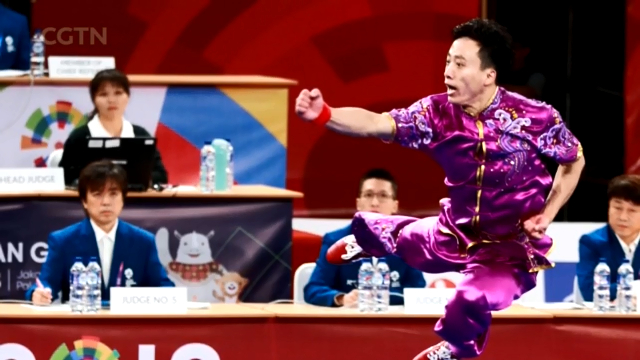
16:54, 20-Aug-2018
2018 Asian Game: WuShu Changquan explained
Updated
16:15, 23-Aug-2018
02:21

We finish with some more about the Asian Games. China's Sun Peiyuan made headlines by winning the first gold of the 2018 edition in Jakarta when he prevailed in men's WuShu Changquan. But many people outside of this continent may not know much about this event which is rapidly growing in popularity worldwide, so here's Mike Fox to explain.
Originating in the Song Dynasty in the 10th century, Chang-quan was developed by founding Emperor Zhao Kuang-yin. The style once named 'Taizu Changquan' refers to a family of external martial arts styles from northern China. The forms of the Changquan style emphasizes fully extended kicks and striking techniques and would be considered a long-range fighting system. The style requires a good balance of hand and foot techniques, but in particular it is known for its impressive acrobatic kicks. Contemporary Changquan is difficult to perform as it requires great flexibility and athleticism, and is more likely to be seen in demonstration events, while its acrobatics are most popular and memorable.
Since Martial Arts first became part of the Asian Games in 1990, China has won seven out of eight gold medals offered in Changquan. The only time China didn't win was in Incheon in 2014 when China did not compete in the event.
The scoring method for Changquan is similar to diving and artistic gymnastics as it is based on judging. Sun Peiyuan's winning score of 9.75 points consisted of 5.0 points based on specific actions, 2.75 points on performance, and 2.0 points based on innovation. During his routine, Sun also completed a combination of side somersaults and flying jump kicks.
Changquan is still not as well known as Judo and taekwondo, and it will not be part of the 2020 Tokyo Olympics, so Changquan must continue to grow to become part of the Olympic catalog. Mike Fox.

SITEMAP
Copyright © 2018 CGTN. Beijing ICP prepared NO.16065310-3
Copyright © 2018 CGTN. Beijing ICP prepared NO.16065310-3